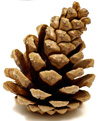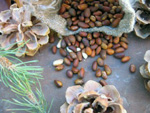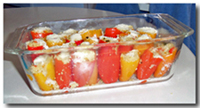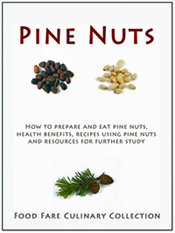|

Click here for Site Menu

Pine Nuts are delectable little gems that when
roasted provide a heavenly treat. They are akin to a guilty pleasure these days
because of their astronomical cost, but still remain a much sought-after
delicacy in my family.
 Usually
available in October, one pound of pine nuts used to go for $7.99. Last year
they were $19.99 per pound, but unfortunately I did not see any due to
harvesting scarcity. Pre-packed and shelled pine nuts for cooking cost roughly
$2.50 per 2.25 ounces (or $29 for 27 ounces) because of the intensive labor
needed in order to obtain them. Usually
available in October, one pound of pine nuts used to go for $7.99. Last year
they were $19.99 per pound, but unfortunately I did not see any due to
harvesting scarcity. Pre-packed and shelled pine nuts for cooking cost roughly
$2.50 per 2.25 ounces (or $29 for 27 ounces) because of the intensive labor
needed in order to obtain them.
Short of foraging amongst the pine trees myself, I
will be sadly devoid of the remarkable taste sensation for this year's autumn
and winter seasons.
Admittedly, pine nuts are an acquired
taste. I know very few people who enjoy them as I do. However, I like to
think others might try pine nuts just once to see what all the fuss
is about. Perhaps then my efforts in writing this article will have been well met.

CONTENTS:
About Pine Nuts
Eating Pine Nuts
Health Benefits of Pine Nuts
Recipes Using Pine Nuts
Links & Resources
Credits & Terms of Use
"Pine Nuts" e-book
Site Menu

About Pine Nuts:
 Pine nuts come from the many folds of
the pine cone and are part of the Pinaceae family. They are often called "seeds"
and have been cultivated for more than six thousand years in Europe, Asia and
North America. They contain protein and dietary fiber, but because of their
small size would not suffice as a whole meal or even as an appetizer. The shells
are difficult to crack, so each torpedo-shaped nut obtained is to be savored. Pine nuts come from the many folds of
the pine cone and are part of the Pinaceae family. They are often called "seeds"
and have been cultivated for more than six thousand years in Europe, Asia and
North America. They contain protein and dietary fiber, but because of their
small size would not suffice as a whole meal or even as an appetizer. The shells
are difficult to crack, so each torpedo-shaped nut obtained is to be savored.
Primary sources for the nuts come
from the Stone Pine (Europe), Korean Pine (Korea),
Chilgoza Pine (Himalaya), as well as Siberian Pine,
Siberian Dwarf Pine, Chinese White Pine and
Lacebark Pine.
The main pine tree species in North
America include Colorado Pinyon, Single-Leaf Pinyon,
and Mexican Pinyon. Other species, such as Gray Pine,
Torrey Pine, and Sugar Pine are also harvested but
less frequently.
Some
historians believe pine nuts date from Israel in 8th century B.C. The first recorded English-speaking
use of pine nuts came in the 12th century in Medieval Britain. According to
historians, Ancient Greeks and Romans believed pine nuts contained aphrodisiac
properties and preserved them in honey. The Greeks in particular felt
Stone Pine was sacred to the God Neptune.
 Pine nuts were once a staple food for Indians in North America.
Native Americans were known to grind the seeds to make soup. Legend has it that a Pueblo Indian maiden ate pine nuts and became pregnant,
later giving birth to Aztec conqueror Montezuma. Pine nuts were once a staple food for Indians in North America.
Native Americans were known to grind the seeds to make soup. Legend has it that a Pueblo Indian maiden ate pine nuts and became pregnant,
later giving birth to Aztec conqueror Montezuma.
Pine nuts are difficult to harvest,
which accounts for their high cost these days. The pine cones are often gathered
from the trees one at a time, or pickers place a tarp at the base of the tree
and knock at the cones in the branches to shake the nuts loose. Once they fall
to the ground, the tarp can be gathered up with the nuts inside. There are
sometimes 100 nuts per cone.
After gathering, pine nuts are dried
for several days and then cleaned. The most common method of cleaning is to use
a wire mesh to separate the nuts from the broken cone scale and bracts (also
known as chaff).
From the
Bureau of Land
Management:
Gathering,
drying, shaking and cleaning pine nuts makes them ready to eat. Pine nuts
are nutritious to eat as is without further enhancement. Their flavor may be
improved by soaking the nuts in salted water, then toasting them in an open
pan in the oven at a moderate temperature. Another method is to wash the
pine nuts in cold water, salt them and put them in a covered roasting pan.
Steam the pine nuts in a moderate oven for 15 to 20 minutes, remove the
cover and stir until completely dry. Most people crack the outer shell with
their teeth and eat the inner nut like eating sunflower seeds.
I've always baked pine nuts to obtain
the best favor and texture.
Eating Pine Nuts:
 Consuming
pine nuts straight from the shell has always been my preferred method. The
process is painstakingly slow, but the taste is well worth it in the end. Consuming
pine nuts straight from the shell has always been my preferred method. The
process is painstakingly slow, but the taste is well worth it in the end.
To bake, spread pine nuts on a
foil-lined baking sheet to avoid pine tar. Bake at 350-degrees F for about twenty
minutes. Allow to cool before eating.
Pine nuts are also available shelled
and pre-packaged in most grocery stores, although the cost per jar can often be
hard to swallow.
The heavy pine flavor of the nuts
might also leave a lingering aftertaste that can last up to three days. This
seems to be more prevalent when the nuts are eaten raw rather than roasted. The
nuts can be eaten raw, but when roasted the flavor tends to be more pronounced
while leaving less bitter aftertaste.
Health Benefits of Pine Nuts:
Pine nuts are high in monounsaturated fat, and include Vitamins, A, C and D.
They also yield pine nut oil, which has a nutty flavor and is said to contain
healthy antioxidants.
Pine nut oil is typically pressed from edible seeds coming from several species
of pine trees. The oil is generally not used during cooking because of its low
smoke-point, but it is often added to dishes at the finish to add the element of
it's flavor.
According to a study undertaken by Lipton Nutrition, pine nut oil can "help curb
appetite by stimulating the release of cholecystokinin, a hormone that
functions as an appetite suppressant."
Other research demonstrates that pine nut
oil can also reduce low-density lipoprotein (LDL's).
Dietary Values of several pine nut species:
| Type of Nut |
Protein % |
Fat % |
Carbs % |
| P. edulis |
14 |
62-71 |
18 |
| P. monophylla |
10 |
23 |
54 |
| P. cembroides |
19 |
60 |
14 |
| P. quadrifolia |
11 |
37 |
44 |
| P. sabiniana |
30 |
60 |
9 |
| P. strobiformis |
28 |
52 |
7 |
| P. pinea |
34 |
48 |
7 |
| P. sibirica |
19 |
51-75 |
12 |
| P.gerardiana |
14 |
51 |
23 |
Table Data Source:
Forestry Department
 Click here for pre-packaged pine nut
nutrition values. Click here for pre-packaged pine nut
nutrition values.
Recipes Using Pine Nuts:
 While
wonderfully satisfying eaten alone, pine nuts can also be added to other foods
to marry the pine flavor with dishes including pasta, fish, vegetables, meats
and rice. While
wonderfully satisfying eaten alone, pine nuts can also be added to other foods
to marry the pine flavor with dishes including pasta, fish, vegetables, meats
and rice.
 Angel Hair with
Scallops & Pine Nuts Angel Hair with
Scallops & Pine Nuts
8 oz. angel hair or
capellini pasta
1 LB sea scallops
1/2 tsp. salt
3 TBS butter
2 garlic cloves,
finely minced
1/2 C unshelled
pine nuts, toasted
1 C Parmesan or
Romano cheese
Cook pasta according to package directions or to
preference; drain. Clean scallops with a paper towel and sprinkle with salt.
Melt the butter in a saucepan; add the scallops and garlic. Cook for three or
four minutes turning once, or until scallops are opaque and golden brown. Remove
from heat. Toast the pine nuts in a large dry skillet over medium heat, stirring
constantly, until they turn a light golden color. Add the pasta and scallops;
toss to mix. Sprinkle with cheese and serve.
 Baked Pine Nuts Baked Pine Nuts
1 LB pine nuts in
shell
Aluminum foil
Preheat the oven to 350-degrees F. Place aluminum
foil on a cookie sheet. Spread pine nuts on cookie sheet evenly. Bake for about
twenty minutes. Allow to cool before eating.
 Catfish with Pine Nuts Catfish with Pine Nuts
1/4 C pine nuts, ground (use mortar &
pestle)
1/2 C cornmeal
1/4 C flour
1 tsp. salt
1/2 tsp. cayenne pepper
1/4 tsp. paprika
1/4 C vegetable oil
1 LB catfish filets
2 TBS pine nuts
In a bowl, combine ground pine nuts with cornmeal,
flour, salt, cayenne pepper and paprika. Heat vegetable oil in a large skillet
over medium heat. Dredge the catfish fillets in cornmeal-flour mixture. Pan-fry
filets for about four minutes on each side, or until fish is opaque. Sprinkle
with additional pine nuts before serving.
 Chicken & Pine Nut Salad
Chicken & Pine Nut Salad
1/2 LB package
mixed salad leaves
2 skinless,
boneless chicken breasts
3 TBS sunflower
oil
6 bacon slices,
chopped
4 TBS Russian or
Catalina salad dressing
1/2 TBS olive oil
4 TBS pine nuts
Salt & black pepper to
taste
Chop the lettuce
into bite-sized pieces; place in a large salad bowl, cover with plastic wrap and
chill until ready to serve. Clean and dry chicken breasts; slice into long
strips. Heat sunflower oil in a wok or a large, non-stick frying pan. Add the
bacon and cook over medium heat until browned and crisp. Remove with a slotted
spoon; drain on paper towels. Leave the bacon fat in the pan (or wok) with the
oil; add the chicken strips and cook over medium-high heat until the meat is no
longer pink.
Remove pan from
the heat; add salt and black pepper to taste. Stir in salad dressing, mixing
well to coat all of the chicken (add more dressing if necessary). Wipe
out the pan and add 1/2 TBS olive oil. Heat on medium high; stir in shelled pine
nuts. Cook long enough to "toast" the nuts, stirring frequently for about two or
three minutes. Stir into the chicken mixture. Take salad bowl from the
refrigerator; toss chicken mixture with the lettuce. Serve at once.
  Couscous Mini Bells
Couscous Mini Bells
1 pkg. (2 LBS)
sweet mini bell peppers
1 box (5.6 oz.)
Near East Couscous Mix with toasted pine nuts
Olive oil or
margarine
Freshly-ground
black pepper to taste
Parmesan or Romano
cheese
Slice tops off mini bell peppers; set aside.
Carefully remove seeds and pinch off white rind from inside the peppers. Rinse
peppers under cold water. Place peppers in a steamer or pan of boiling water;
cook, covered, for about thirty to forty-five minutes (or until peppers are
somewhat tender but not too soft). Cut the edible portions from pepper tops;
chop fine and then sauté in olive oil or margarine with black pepper until soft.
Set aside. Cook couscous according to package directions. Add sautéed bits of
pepper tops; stir. Allow mixture to cool slightly. Place steamed peppers in a
glass dish so that they stand upright, leaning one against the other if
necessary. Spoon couscous mixture into each pepper until even on top. Sprinkle
with Parmesan or Romano cheese. Warm in the microwave for about one minute;
serve. Note: Adding salt is not necessary as there is more than enough
salty taste in the couscous seasoning packet. Suggestions: For
Couscous Mini Bells, try using fresh mini bell peppers from
Primetime Produce
and the toasted pine nut variety couscous from
Near East.
*Couscous Mini Bells images (C)
Shenanchie.
 Green Beans with Pine
Nuts Green Beans with Pine
Nuts
1/4 C pine nuts, toasted
1-1/2 LBS green beans, trimmed & cut
into 1/2" pieces
2 TBS lemon juice
2 tsp. Olive oil
Salt & black pepper to taste
Toast the pine nuts in a baking dish in a
350-degree F oven for about three or four minutes, shaking the baking dish
frequently. Steam green beans in boiling water or in an electric steamer-cooker
until tender. Drain green beans and transfer to a serving bowl. Toss with
toasted pine nuts, lemon juice, olive oil, salt and black pepper. Serve.
 Judias
Verdes con Salsa de Tomate (Green
Beans in Tomato Sauce; Spain)
Judias
Verdes con Salsa de Tomate (Green
Beans in Tomato Sauce; Spain)
2 TBS olive oil
2 cloves garlic, crushed
2 LBS (5 C) green beans, cut into 1" lengths
1-1/2 LBS canned tomatoes with juice, chopped
1 TBS chives, chopped
Salt & black pepper to taste
1 bay leaf
1 TBS pine nuts
1 TBS lemon juice
In a large cooking pot, sauté the garlic in the
olive oil for about two minutes, stirring. Add the beans and cook for about four
minutes, stirring constantly. Stir in the tomatoes with the liquid from the can.
Add chopped chives, salt and black pepper, bay leaf, pine nuts and lemon juice.
Bring mixture to a boil, stirring constantly. Reduce heat to low and simmer for
about twenty to twenty-five minutes. Remove and discard the bay leaf. Serve at
once.
 Marak Tarator
(Jewish cold cucumber soup) Marak Tarator
(Jewish cold cucumber soup)
3-1/2 C plain yogurt
3/4 C sour cream
3 garlic cloves, minced
6-8 small cucumbers, peeled & finely chopped
1/4 C cold water
Salt to taste
1/4 C fresh dill, finely chopped
1/4 C fresh mint, finely chopped
Crushed walnuts or lightly toasted pine nuts (for
topping)
Drizzle of olive oil (for topping)
In a bowl, mix together all ingredients (except
for nuts and olive oil). Cover and chill in the refrigerator for several hours.
Top with nuts and olive oil before serving. Note: For thicker soup, omit
water. Suggestion: Serve with crusty bread.
 Pashtida
(Jewish Spinach Quiche)
Pashtida
(Jewish Spinach Quiche)
2 TBS butter
2 TBS olive oil
6 TBS white wine (optional)
1 LB fresh
spinach, washed & patted dry
Salt & black
pepper to taste
1 LB labneh*
2 TBS
Tahini
2 eggs, beaten
1/2 C flour
1/2 tsp. baking
powder
1/4 C pine nuts (for
topping)
Heat the olive oil
or half the butter in a large skillet. Add half of the spinach gradually; stir
constantly with a wooden spoon. Add half of white wine; season with salt and
black pepper. Mix well. Cook until spinach leaves wilt; place spinach in a
strainer. Repeat with remaining spinach and wine; season with salt and black
pepper. Allow spinach to drain for about ten minutes, and then transfer to a
large bowl. Preheat oven to 350-degrees F; grease a baking pan with olive oil.
In a bowl, mix together the labneh, Tahini, beaten eggs, salt and pepper. Add
flour and baking powder; mix well. Pour evenly into prepared baking pan. In a
small skillet, toast pine nuts with a small amount of olive oil over high heat,
stirring constantly, until pine nuts turn golden in color. Transfer pine nuts to
a plate and blot with a paper towel to remove excess oil. Sprinkle pine nuts on
top of spinach mixture in baking pan. Bake in the center oven for about
thirty-five minutes, or until mixture sets and top turns golden in color. Remove
from oven and allow to stand for about ten minutes before serving.
*Note: Labneh is a strained yogurt
product available in most Middle Eastern specialty stores.
 Pine Nuts in Sugar
(Nucibus Pineis Saccharo Conditi; Medieval)
Pine Nuts in Sugar
(Nucibus Pineis Saccharo Conditi; Medieval)
1 C pine nuts,
shelled
1 C sugar
Melt the sugar in
a clean, dry pan for about ten minutes over medium-high heat. When sugar melts,
add shelled pine nuts and stir to coat. Remove pan from heat. Allow to cool
before forming the mixture into shapes similar to cylinders. Make each
"cylinder" about 6" long and roughly 2" wide. Serve.
 Pine Nut Pesto Pine Nut Pesto
2 TBS pine nuts, coarsely chopped
2 garlic cloves, peeled
3 TBS extra-virgin olive oil
4 C basil leaves (4 oz.)
1/2 C fresh Parmesan cheese, grated
1/4 tsp. salt
Using a food processor, process the
pine nuts and garlic until finely minced. Add olive oil and pulse three times.
Then add the basil, Parmesan cheese and salt to the processor bowl. Process
until finely minced, scraping down the sides. Toss with cooked pasta. Note:
Refrigerate leftovers and use within seven days.
 Pokerounce (Medieval bread & honey)
Pokerounce (Medieval bread & honey)
8 oz. honey
Pinch each of
ginger, cinnamon, black pepper & nutmeg
Sliced bread
1 TBS pine nuts
Place the honey in
a saucepan, and then add the spices. Stir over low heat until the honey and
spices are well-blended. Be careful not to let the honey burn. Cool the mixture.
Toast individual slices of bread (bread quantity will depend on how much of
the honey mix you dollop on each slice). Cut the slices of bread into
quarters (either square or lengthwise); lay flat on a plate or cookie
sheet. Drizzle honey mixture over toast pieces; place the pine nut kernels
upright into the bread so they are erect. Make patterns with the pine nuts, or
eat the toast as is.
 Spaghetti Squash with
Pine Nuts Spaghetti Squash with
Pine Nuts
1 spaghetti squash, halved lengthwise
& seeded
1/4 C toasted pine nuts
1/4 C Romano cheese, grated
2 TBS fresh parsley, chopped
2 tsp. butter, melted
Salt & black pepper to taste
Preheat the oven to 350-degrees F. Place squash
cut side down in a large baking dish. Bake the squash for about fifty minutes.
Using a fork, scrape the flesh from the squash and place in a bowl. Add the pine
nuts, cheese, parsley, butter, salt and black pepper; toss to combine. Serve at
once.
  Stuffed
Tomatoes Stuffed
Tomatoes
1 box (5.6 oz.)
Couscous Mix with Toasted Pine Nuts (Near East brand)
1/4 C onion, finely
chopped
4 large tomatoes,
ripe but firm
Olive Oil
Non-stick cooking
spray
Preheat oven to 350-degrees F. Prepare couscous
mix according to package directions; set aside. Rinse tomatoes under cold water.
Cut the top off of each tomato. Remove core from tops and finely chop remaining
flesh; set aside. Using a spoon, carefully scoop out tomatoes; turn upside down
on paper towels to drain. Discard pulp and seeds. Heat two tablespoons of olive
oil in a large skillet over medium to high heat. Add chopped onion and cook
until soft, about three minutes, stirring frequently. Add chopped tomato tops;
mix well. Reduce heat to low and simmer, about four minutes. Remove from heat
and add the prepared couscous. Mix until well blended. Fill tomatoes with
mixture, patting down with a spoon to create even tops. Place filled tomatoes in
a baking pan coated with non-stick cooking spray. Drizzle olive oil on tomatoes.
Bake until tender but still firm, about twenty-five minutes. Serve. Note:
Food Fare's recipe for Stuffed Tomatoes is loosely based on the Iraqi
dish known as Yalanchi, which uses white rice, raisins and pine nuts as a
stuffing for tomatoes. *Stuffed Tomatoes
images (C) Shenanchie.
 More recipes using Pine Nuts >
More recipes using Pine Nuts >
Pine Nut Links & Resources:
Diamond Nuts
Good from the Woods
How to Cook with Pine Nuts
Pine Nut Harvest
Regions
Pine Nut Oil
Pine Nut
Species
Pinon Nuts.Org (BLM
Colorado)
Pinion Penny Blog
Popularity of Pignoli (Epicurean)
Red River Foods
The Nut Factory (Pine Nuts)
Wholesale Pine Nuts
Wikipedia (Pine
Nuts)
Wild Crops Pine Nuts
Credits & Terms of Use:
(C)
Shenanchie
Reprinted exclusively for Food Fare
"Pine Nuts" was written for entertainment purposes only and expresses the sole
opinions of the author. This article is not meant to be a professional
chef's essay about pine nuts, but rather an observation about the generalities of
pine nuts from an amateur home kitchen.
You are free to use the material in this article as reference, but if you
happen to use direct wording from this piece, we would appreciate the credit.
Thank you.
To send Shenanchie a comment about Pine Nuts, click
here.
"Pine Nuts" e-book edition:
Food Fare also provides the e-book edition of
Pine Nuts
as part of our
Culinary Collection. The Kindle and Nook editions contain bonus recipes
and information.
Click here
for more.

Food Fare Site Menu:

^ Back to top of page ^
|